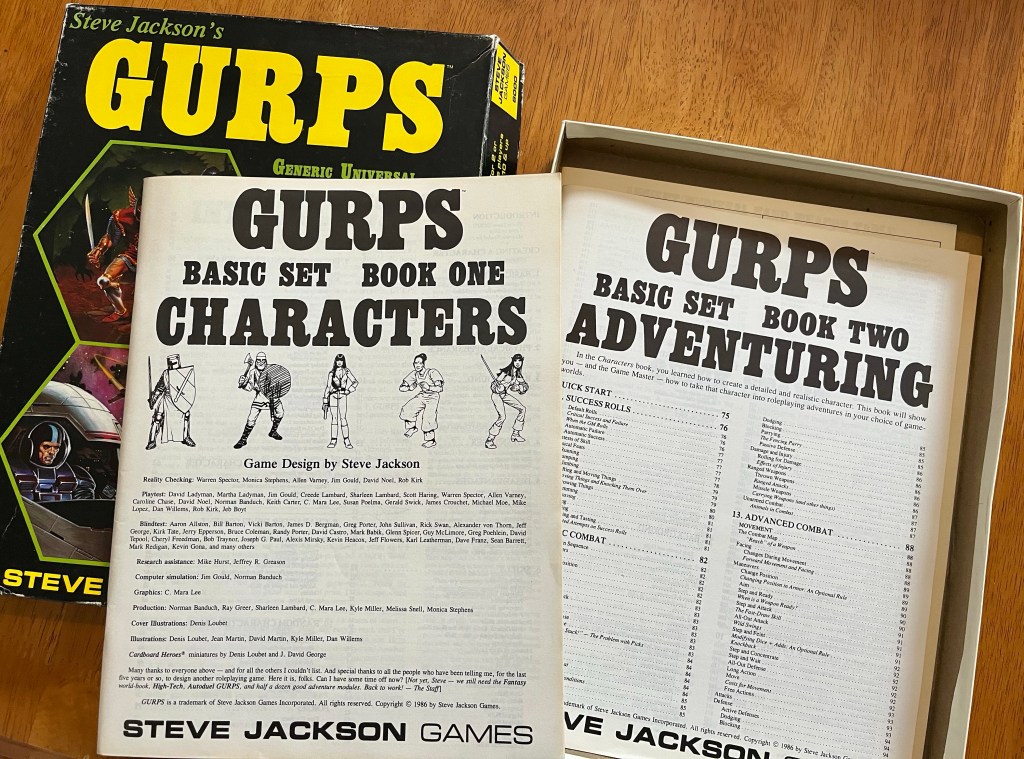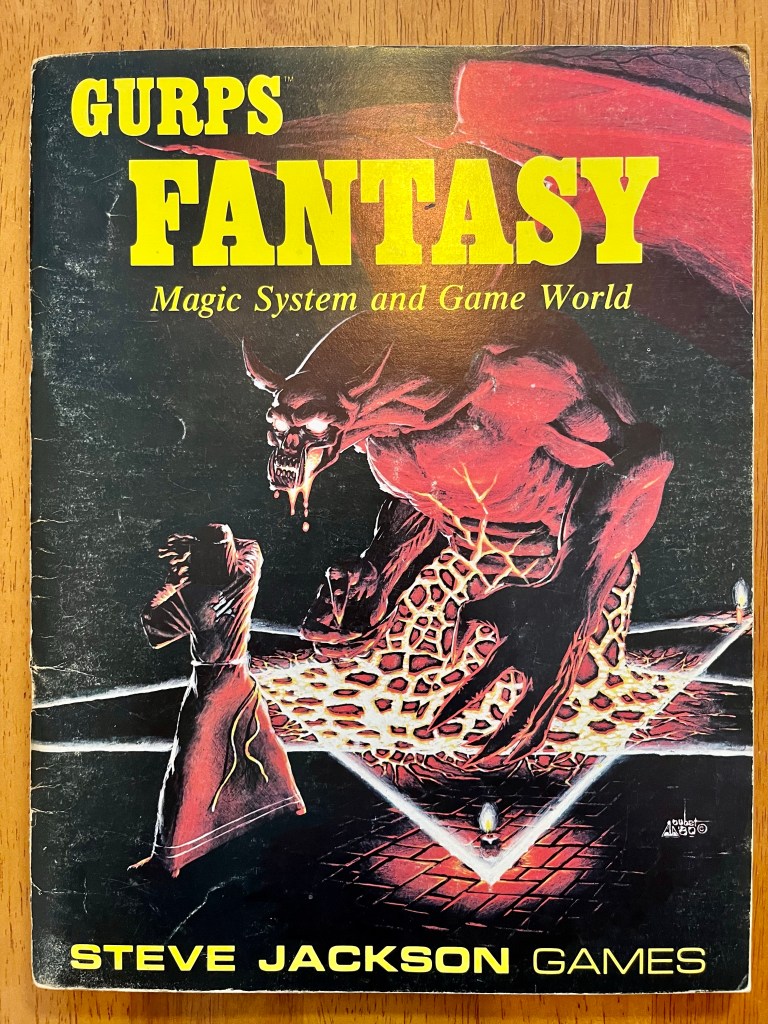My experience with GURPS began back around 1998 when I bought a copy of the Third Edition Revised rules, although even back then I didn’t get to bring the game to the table. When Fourth Edition arrived in 2004, I enthusiastically collected the GURPS books as they were released. There were two or three false-starts with GURPS for me, but I really didn’t get into the game properly until about 3 years ago.

Some months back, I picked up a copy of the GURPS 1st Edition Boxed Set for a pittance. Fascinated as I am about the evolution of key roleplaying games, I also managed to pick up Man-to-Man around the same time. I spent a day or two exploring the sets and then did my usual thing of getting distracted.
There is something very attractive about the early GURPS products. There is no real nostalgia for the game itself because while I had heard of it around 1989 when I went to University, I had only seen it from afar on the shelf of the FLGS. By the time I was working and could afford the book, GURPS Third Edition was the standard. That said, I do love the 1980s aesthetic: black-and-white booklets, an art style that has its own flavour, and very easy-on-the-eyes text.

Going back to the beginning, I was surprised at how simple and straight-forward the core of the game was and still is. The first thing to note is that, for all the talk of editions, GURPS hasn’t changed all that much. Certainly the details have evolved – especially around specific character traits and the value of things – but the core game is the same. It’s also really easy to understand: roll 3d6, score low is the core mechanism.
The current Fourth Edition intimidates me as a player and GM. This boxed set really doesn’t. Maybe it’s the small booklets and much-reduced choice, or maybe it’s just at the beginning of what was to become an incremental addition of detail, but the Basic Set is very accessible.
You get two books, a charts and tables booklet, the adventure booklet, and some cardboard miniatures.

Book One Characters gives the player everything they need to learn the game and create a character. Although the game claims to be able to handle anything (which I believe to be true), you might be forgiven for lamenting the Basic Set’s focus on ancient and medieval / fantasy plus modern-era (for the 1980s) high-tech equipment. There’s no magic system or psionics included, and no ultra-tech for SF.
Book Two Adventuring covers the core rules (in just 6 pages) before introducing basic combat rules (5 pages). From there you get advanced combat (21 pages), rules for injuries and other dangers (7 pages), and chapters for Game Mastering (7 pages), Background – by which is meant building your own settings (9 pages), animals and how to run them (4 pages), and writing your own adventures to finish (5 pages). There’s a glossary and index for both books which are also sequentially numbered: Book One is pages 1-72, Book Two from pages 73-152.
Mucking about with it, I made a character for my Stargate game in about 30 minutes, including reading time. It’s the familiar GURPS character points system at core but I did enjoy seeing the Random Characters chapter in Book One. The game plays smoothly, although my familiarity with Fourth Edition may be a factor. There are significant points of difference – such as the Passive Defence value of armour and shields, not just the Damage Resistance value in the later edition – but these are details. The core of GURPS is unchanged.
Overall, I was encouraged to play more. Although I can already see why Fourth Edition is a quantum leap forward in terms of the completeness of the Generic Universal Role Playing Game, it’s nice to explore the piece-by-piece growth and evolution of the game over the two decades prior.

I have the GURPS Fantasy supplement, also from 1986, which adds the magic system and a game world ready to play within. I think this publication strategy was a strength back in the early days because players and GMs would incrementally master the game as it was published. Nowadays, the neophyte is confronted with the whole game at once. This was enough to put me off for the longest time.
What next? Well, I will take a look at the Third Edition on the way through but I feel encouraged to use these old products to inspire a game using GURPS Fourth Edition as the engine. What’s wonderful is that, given the conversion guides and some common sense, it’s pretty trivial to update to Fourth Edition from any old sourcebook.
What is particularly delightful in GURPS First Edition is the inclusion of many pre-generated NPCs and creatures. I find the small stat entries and encouragement to use index cards very much more accessible. I know this has always been part of GURPS but somehow the First Edition boxed set communicated it far more clearly to me.
Game on!

Loving your journey through early editions of GURPS. Having done this with D&D I’d love to do this with GURPS as well. It’s one of the reasons I looked into The Fantasy Trip. I have some stuff around so you may have inspired me to do some playing with it.
From memory, passive defence is still around in GURPS 3e. They only recently dropped it and increased the effectiveness of the active defences, but I’d love to see how those compare as you look through the editions.
Game on!
LikeLiked by 1 person
Yeah, it’s fun to explore the journey and evolution of the game. Yes, PD was a feature until 4e when it was subsumed into the Active Defences. You should absolutely come play!
LikeLike
Reblogged this on DDOCentral.
LikeLike
[…] through to the 2004 arrival of GURPS Fourth Edition. As I wrote earlier in the week, the aesthetic of the GURPS Basic Set, First Edition and the ease with which I got to playing stood in contrast to my frustrated first attempts to get […]
LikeLike
[…] to play through the adventure for themselves. That said, as it was first published in 1986 with GURPS First Edition, I consider this less problematic than usual. Your mileage may vary, however, so you have been […]
LikeLike
For me, GURPS isn’t a RPG but a kit to build your own RPG. It is GM intensive because you have to figure out how much of the rules you want and what books to add.
LikeLiked by 1 person
“Going back to the beginning, I was surprised at how simple and straight-forward the core of the game was and still is.”
I completely agree with this. Everything about the set is designed to give the best possible first time experience to the largest number of people possible.
As a kid, the lack of psi, magic, and space stuff was a huge barrier. I wish that some kind of designers note article could have explained how great what actually was there really was.
Something like Orcslayer would have been a good thing for me then. Alas, I never saw a copy for sale anywhere!
LikeLiked by 1 person
[…] year, things began to change. I opened up my GURPS First Edition boxed set in August and something began to […]
LikeLike